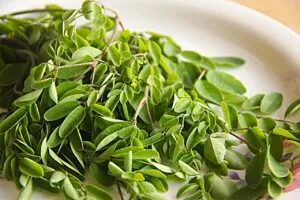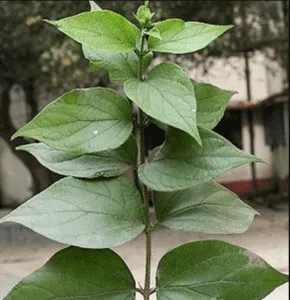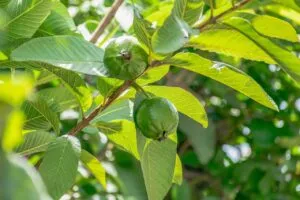5 Plants for their Beneficial Leaves (Ayurvedic)
Plants are truly a blessing on earth, offering countless benefits, from providing food and medicine to enhancing our environment and well-being.
In this article, we will learn about five such plants that are especially beneficial for health due to the medicinal (ayurvedic) properties present in their leaves.

These plants are easy to grow at home and can be incorporated into your daily routine to improve overall health.
3. Moringa plant
4. Night Blooming Jasmine (Parijat/Harsringar) Plant
5. Guava plant
1. Curry Leaves: A Natural Elixir for Hair and Health

Curry leaves are well-known for their remarkable benefits, especially in promoting healthy hair, treating hair fall and making it thicker and more resilient.
Incorporating curry leaves into your diet can also aid in weight loss, regulate cholesterol levels, enhance brain function, and combat cancer cells.
The versatility of curry leaves allows them to be added to meals in various ways:
1. Tempering: Use curry leaves as a flavorful addition to vegetables, pulses, and other dishes.
2. Chapatis: Mix curry leaves into flour to make nutritious chapatis.
3. Chutneys: Prepare chutneys by blending curry leaves with coriander and mint leaves.
The curry leaf plant is easy to grow and care for, making it a must-have in every home to take advantage of its numerous health benefits.
Click here to read: How to grow & care Curry Leaf Plant
2. Tulsi Leaves: The Holy Basil for Immunity and Vitality

Tulsi, often referred to as an herb for all seasons, is revered for its ability to boost immunity and provide relief from common ailments like cold and cough.
- It is particularly beneficial for those managing diabetes, as tulsi extract, when consumed alongside medication, can accelerate recovery.
- Tulsi also helps regulate blood pressure, supporting both systolic and diastolic levels.
By improving the function of beta cells in the pancreas, tulsi addresses the root cause of diabetes—insulin resistance.
Tulsi can be consumed in various ways:
1. Herbal Tea: Make a kadha by boiling tulsi leaves in water.
2. Morning Ritual: Swallow 3-4 leaves on an empty stomach.
3. Infused Water: Add a few leaves to your drinking water for a refreshing sip throughout the day.
As a sattvic plant, tulsi is believed to bring positivity and promote vibrant energy. Tulsi plants are easy to grow, and their seeds spread naturally, allowing new plants to sprout effortlessly.
Click here to read: How to grow & care Tulsi plant at home
3. Moringa Leaves: A Nutrient-Packed Superfood

Moringa leaves, derived from the Moringa tree (often called Sahjan), are recognized as a superfood due to their impressive nutrient profile.
Moringa leaves contain:
1. Iron: 25 times more iron than spinach
2. Potassium: 15 times more potassium than bananas
3. Vitamin A: 10 times more vitamin A than carrots
4. Protein: 9 times more protein than curd
5. Vitamin C: 7 times more vitamin C than oranges
6. Calcium: 14 times more calcium than milk
Moringa is one of the few natural foods with multivitamin properties and is rich in vitamin B12.
The leaves can be added to various dishes such as vegetables and pulses, or even mixed into chapati dough. While Moringa powder is available in the market, fresh leaves are healthier and more flavorful.
The Moringa plant grows easily and quickly, making it suitable for home gardening. It’s best to plant it in a large pot to accommodate its rapid growth.
4. Parijat Leaves: A Remedy for Pain and Fevers

Parijat, also known as Harshringar or Night blooming jasmine, is renowned for its medicinal properties, particularly in treating three primary health issues:
1. Body Pain and Arthritis:
Parijat leaves are highly effective in relieving body pain, arthritis, and sciatica.
- Prepare a remedy by crushing 3-4 leaves, boiling them in water, and drinking the strained liquid.
2. Fever Reduction:
A decoction made from Parijat leaves helps reduce body temperature, offering a natural alternative to paracetamol, especially during fevers caused by malaria, chikungunya, and dengue.
3. Respiratory Health:
Parijat leaves also address respiratory issues such as asthma, excessive phlegm, or breathing difficulties.
- Their anti-inflammatory and antimicrobial properties promote a healthy, glowing complexion.
Parijat plants can be easily grown in pots and are available at nurseries. They can also be propagated from cuttings.
Click here to read: How to grow & care Parijat plant at home
5. Guava Leaves: Natural Care for Oral and Digestive Health

Guava tree leaves are highly effective in treating mouth ulcers, bad breath, tooth decay, pain, and bleeding gums. Simply chew 1-2 leaves under your teeth, swallow the juice, and discard the leftover residue.
Guava leaves can also be used to make a decoction by boiling chopped leaves in water.
For women, guava leaf extract acts as a natural painkiller during menstruation.
It is also beneficial for treating irritable bowel syndrome (IBS) and contains an oil that is four times more potent in fighting cancer than conventional medicines.
- Guava plants are easy to grow and readily available at nurseries.
Conclusion
These five plants for their beneficial leaves (ayurvedic) offer remarkable health benefits and can serve as natural alternatives to allopathic supplements. They are easy to grow at home and, in addition to treating various ailments, can help prevent future diseases. Incorporating these plants into your daily routine can bring about transformative changes, essential for maintaining a healthy body.
Follow our Social media channel:
1.Voice of Plant – YouTube Channel
2.Voice of Plant Facebook Page
3.Instagram Voice of Plant Channel
Happy gardening!






